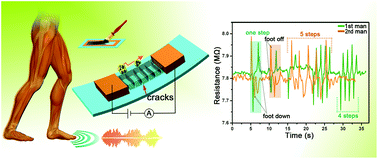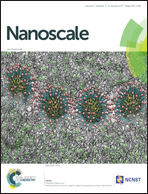Superfast and high-sensitivity printable strain sensors with bioinspired micron-scale cracks†
Abstract
Functional electronics has promising applications, including highly advanced human-interactive devices and healthcare monitoring. Here, we present a unique printable micron-scale cracked strain sensor (PMSCSS), which is bioinspired by a spider's crack-shaped lyriform slit organ. The PMSCSS is fabricated by a facile process that utilizes screen-printing to coat carbon black (CB) ink onto a paper substrate. With a certain bending radius, a cracked morphology emerged on the solidified ink layer. The working principle of the PMSCSS is prominently attributed to the strain-dependent variation in resistance due to the reconnection–disconnection of the crack fracture surfaces. The device shows appealing performances, with superfast response times (∼0.625 ms) and high sensitivity (gauge factor = 647). The response time surpasses most recent reports, and the sensitivity is comparable. We demonstrate the application of the PMSCSSs as encoders, which have good linearity and negligible hysteresis. Also, the sensor can be manipulated as a vibration detector by monitoring human-motion disturbances. According to the sensory information, some details of movements can be deduced.



 Please wait while we load your content...
Please wait while we load your content...